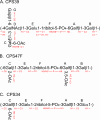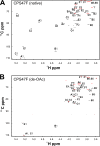Chemical structures of Streptococcus pneumoniae capsular polysaccharide type 39 (CPS39), CPS47F, and CPS34 characterized by nuclear magnetic resonance spectroscopy and their relation to CPS10A
- PMID: 25002537
- PMCID: PMC4135690
- DOI: 10.1128/JB.01731-14
Chemical structures of Streptococcus pneumoniae capsular polysaccharide type 39 (CPS39), CPS47F, and CPS34 characterized by nuclear magnetic resonance spectroscopy and their relation to CPS10A
Abstract
Structural characterization of Streptococcus pneumoniae capsular polysaccharides (CPS) is a prerequisite for unraveling both antigenic and genetic relationships that exist between different serotypes. In the current study, comparative structural studies of S. pneumoniae CPS serogroup 10 (CPS10) were extended to include genetically related S. pneumoniae CPS34, CPS39, and CPS47F. High-resolution heteronuclear nuclear magnetic resonance (NMR) spectroscopy confirmed the published structure of CPS34 and, in conjunction with glycosyl composition analyses, revealed the following repeat unit structures of the other serotypes, which have not been previously characterized: [structure: see text] Common and unique structural features of these polysaccharides, including different positions of O-acetylation, were unambiguously associated with specific genes in each corresponding cps locus. The only exception involved the gene designated wcrC, which is associated with the α1-2 transfer of Gal pyranoside (Galp) to ribitol-5-phosphate in the synthesis of CPS10A, CPS47F, and CPS34 but with α1-1 transfer of Gal to ribitol-5-phosphate in the synthesis of CPS39. The corresponding gene in the cps39 locus, although related to wcrC, more closely resembled a previously identified gene (i.e., wefM) of Streptococcus oralis that is associated with α1-1 transfer of Galp to ribitol-5-phosphate. These and other recent findings identify linkages from α-Galp to ribitol-5-phosphate and from this residue to adjacent Gal furanoside (Galf) as important sites of CPS structural and genetic diversity.
Copyright © 2014, American Society for Microbiology. All Rights Reserved.
Figures





Similar articles
-
Structures of Capsular Polysaccharide Serotypes 35F and 35C of Streptococcus pneumoniae Determined by Nuclear Magnetic Resonance and Their Relation to Other Cross-Reactive Serotypes.J Bacteriol. 2015 Sep;197(17):2762-9. doi: 10.1128/JB.00207-15. Epub 2015 Jun 8. J Bacteriol. 2015. PMID: 26055112 Free PMC article.
-
Comparative structural and molecular characterization of Streptococcus pneumoniae capsular polysaccharide serogroup 10.J Biol Chem. 2011 Oct 14;286(41):35813-35822. doi: 10.1074/jbc.M111.255422. Epub 2011 Aug 22. J Biol Chem. 2011. PMID: 21859716 Free PMC article.
-
Structural, Biosynthetic, and Serological Cross-Reactive Elucidation of Capsular Polysaccharides from Streptococcus pneumoniae Serogroup 16.J Bacteriol. 2019 Sep 20;201(20):e00453-19. doi: 10.1128/JB.00453-19. Print 2019 Oct 15. J Bacteriol. 2019. PMID: 31383737 Free PMC article.
-
Characterization of the capsular polysaccharide biosynthesis locus of Streptococcus pneumoniae type 19F.Microb Drug Resist. 1997 Spring;3(1):89-99. doi: 10.1089/mdr.1997.3.89. Microb Drug Resist. 1997. PMID: 9109099 Review.
-
Bacterial capsular polysaccharide and sugar transferases.Adv Biochem Eng Biotechnol. 2004;90:89-111. doi: 10.1007/b94193. Adv Biochem Eng Biotechnol. 2004. PMID: 15453186 Review.
Cited by
-
Discovery of a Streptococcus pneumoniae serotype 33F capsular polysaccharide locus that lacks wcjE and contains a wcyO pseudogene.PLoS One. 2018 Nov 5;13(11):e0206622. doi: 10.1371/journal.pone.0206622. eCollection 2018. PLoS One. 2018. PMID: 30395578 Free PMC article.
-
Rewiring the pneumococcal capsule pathway for investigating glycosyltransferase specificity and genetic glycoengineering.Sci Adv. 2023 Sep 8;9(36):eadi8157. doi: 10.1126/sciadv.adi8157. Epub 2023 Sep 6. Sci Adv. 2023. PMID: 37672581 Free PMC article.
-
Structures of Capsular Polysaccharide Serotypes 35F and 35C of Streptococcus pneumoniae Determined by Nuclear Magnetic Resonance and Their Relation to Other Cross-Reactive Serotypes.J Bacteriol. 2015 Sep;197(17):2762-9. doi: 10.1128/JB.00207-15. Epub 2015 Jun 8. J Bacteriol. 2015. PMID: 26055112 Free PMC article.
-
A New Pneumococcal Capsule Type, 10D, is the 100th Serotype and Has a Large cps Fragment from an Oral Streptococcus.mBio. 2020 May 19;11(3):e00937-20. doi: 10.1128/mBio.00937-20. mBio. 2020. PMID: 32430472 Free PMC article.
-
Modeling of pneumococcal serogroup 10 capsular polysaccharide molecular conformations provides insight into epitopes and observed cross-reactivity.Front Mol Biosci. 2022 Aug 8;9:961532. doi: 10.3389/fmolb.2022.961532. eCollection 2022. Front Mol Biosci. 2022. PMID: 36003080 Free PMC article.
References
-
- Pilishvili T, Noggel B, Moore MR. 2012. Chapter 11. Pneumococcal disease. In Roush SW, McIntyre L, Baldy LM. (ed), Manual for the surveillance of vaccine-preventable diseases, 5th ed. Centers for Disease Control and Prevention, Atlanta, GA
-
- Lund E, Henrichsen J. 1978. Laboratory diagnosis, serology and epidemiology of Streptococcus pneumoniae, p 241–262 In Bergan T, Norris JR. (ed), Methods in microbiology. Academic Press, London, England
-
- Yother J. 2004. Capsules, p 30–48 In Tuomanen EI. (ed), The pneumococcus. ASM Press, Washington, DC
-
- Bentley SD, Aanensen DM, Mavroidi A, Saunders D, Rabbinowitsch E, Collins M, Donohoe K, Harris D, Murphy L, Quail MA, Samuel G, Skovsted IC, Kaltoft MS, Barrell B, Reeves PR, Parkhill J, Spratt BG. 2006. Genetic analysis of the capsular biosynthetic locus from all 90 pneumococcal serotypes. PLoS Genet. 2:e31. 10.1371/journal.pgen.0020031 - DOI - PMC - PubMed
Publication types
MeSH terms
Substances
Grants and funding
LinkOut - more resources
Full Text Sources
Other Literature Sources

